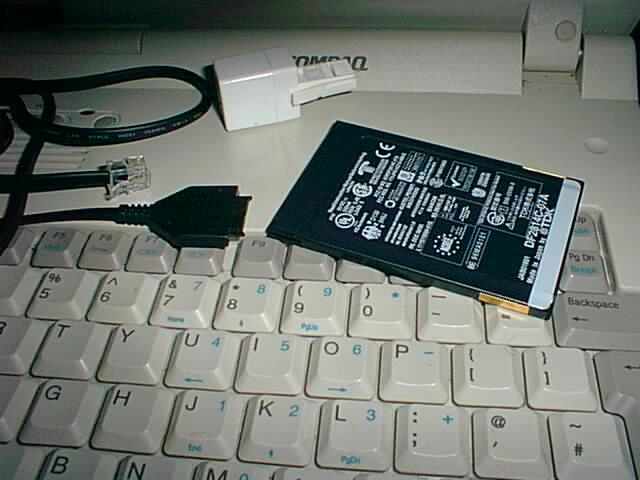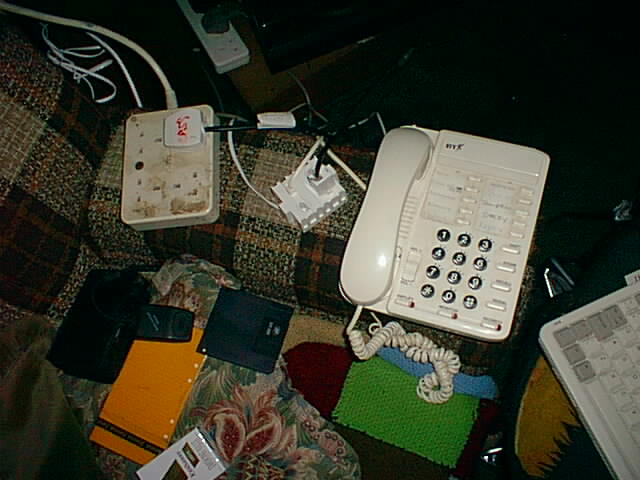Forums › Life › Computers, Gadgets & Technology › The Internet › Getting online in late 1990s…
I found these photos one one of my hard drives (there’s also a load of rave photos which I will upload here as it should be safe to do so after 18 years…) the second hand Compaq laptop weighed more than this one I am currently using, only had a 640 x 480 display and I had to carry around a second accu if I wanted to use it away from a 230v mains supply for more than 1.5 hours…
It dit not come with a built in modem ; you had to insert the card into a slot on the side.
I remember that modem being quite advanced for the era, the markings are official approval signs from various Communications Ministries across the world – you had to set the driver correctly for your local telephone company’s signalling or it would not work properly.

the other end plugged into the telephone line; unlike todays ADSL/VDSL modems it actually made a telephone call and used audio frequencies so no one else could use the phone when you were online and you had to pay for the length of time you were connected to the ISP (usually it was local call rate).
This was taken round af friends house somewhere in Reading; the 3.5″ disk would have contained drivers for the modem and other notes as the signalling and levels varied very subtly depending on whether you were connecting to a BT or NTL circuit. Also bad wiring in the building would often upset the modem to the point it didn’t connect or ran slow; top speed was 56 kilobits ( 56 000 bits/second)
Although I could connect with my GSM mobile and we had free minutes back then it was even slower at 9600 bits/second – so the Internet was then only useful for email, newsgroups (a bit like this forum but text only) and downloading a file from a known location (which could take several hours rather than seconds/minutes).

Hey that was an awesome post my friend :D. My god dial-up was a nightmare but after watching BBS: The Documentary, they used gto measure spead in BAUD (don’t remember what that stands for) and started at about 30 BAUD. That speed was putting 30 characters of text per second across the wire. You could read faster than the text culd be transfrerred lol. Things improved by several generations I believe before thyey even started measuring the speed in kilobits/second.
baud (Bd) is defined as the amount of symbols per second that can be transmitted via a communications circuit so is normally equivalent to bits per second. it is named after Émile Baudot, a Frenchman who invented the original ITA2 (International Telecommunication Alphabet 2) signalling with 5 bits for a letter/number/symbol.
This is still used today by the Germans for transmitting the sea weather via radio.
Most modern systems use ITA5 with 8 bits for the data (one byte/octet) but there are two extra signals to keep the circuit in sync; known as start and stop bits. Unfortunately I am still at work in bumpkinshire dealing with some Windows updates or I would upload a picture from an RS232 link connected to an oscilloscope showing how all this fits together as it is easier to understand if you can see the signals.
Many BBS systems from the 70s did use 300 baud/bps with 30 octets transmitted per second. this slow speed was often all the noisy telephone lines and acoustic couplers could cope with; until the 90s the PTT did not allow unapproved equipment to be directly connected to phone lines in case it caused interference to other circuits or worse; sent strong voltage down the line which is dangerous to the engineers in the Telephone Exchange.m By the 1980s most modems worked at 1200 bps; in Europe we had Viewdata which was 1200bps downstream and 75 bps upstream (like ADSL but way slower).
There were plans for UK, FR, DE, NL to all have ISDN circuits to all homes/businesses at 128 000 bps [as digital telephone exchanges could easily work with these] and a Viewdata based version of the Internet in the mid 1980s (which allowed you to use computers and other equipment at the same time as the normal telephone) – but Thatcho privatised British Telecom and the bosses pulled out of the main European project. I was told this in 1987 during work experience at BT by one of their senior engineers and it matches up with other stuff I have found online from that era…
BT also kept a lot of ropey old analogue equipment running well into the late 1990s. It didn’t help either that Britain still behaved as it was fighting WW II well into the 1980s and ISDN was a German invention…

The Germans and French (and many other mainland European countries) kept the nationalised PTT and invested more in basic infrastructure – they did carry on with their local versions of these systems (BTX and Minitel) and made these services affordable to younger people which is why they were way ahead of the UK by the early 1990s, this is something which isn’t that well known unless you learn the languages….
Awesome post as always my friend :D. Had hear of Mr Baudot before but never even considered there might be a connection lol.
0
Voices
2
Replies
Tags
This topic has no tags
Forums › Life › Computers, Gadgets & Technology › The Internet › Getting online in late 1990s…